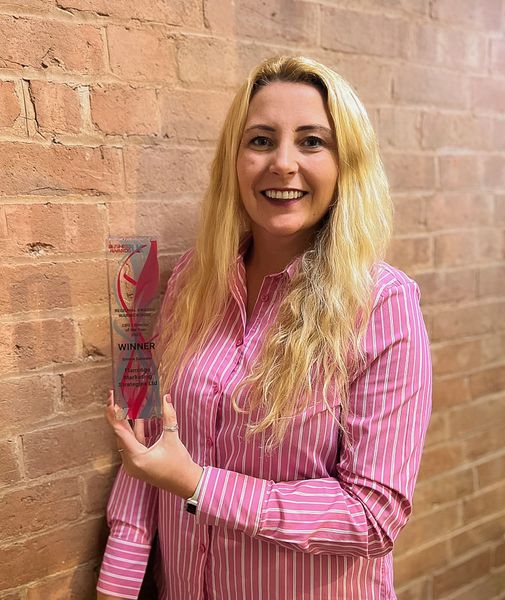
Get to know the Founder and Managing Director of Flamingo Marketing Strategies, a top-notch provider of customized marketing solutions for small and medium-sized enterprises. In this exclusive interview, we delve into their successful strategies, from promoting team cohesion with effective tools and regular meetings to cultivating a positive work culture through quarterly performance assessments and individual incentives. Explore their highly acclaimed Prospect100 lead generation service and outstanding expertise in email marketing, as demonstrated by satisfied clients. Discover their approach to creating captivating and genuine content, along with their techniques for impactful photography and videography. Gain insights into how they utilize social media for personalized interaction and prioritize employee satisfaction. Additionally, learn about their dedication to innovation, deep understanding of brands, and commitment to maintaining work-life balance in this fast-paced industry.
[ez-toc]
As the Founder and Managing Director of Flamingo Marketing Strategies, you offer a wide range of marketing services for SMEs. How do you ensure that your team maintains a cohesive approach while delivering customized solutions to your clients?
Every month, we set objectives for each client that exist on a one-page overview that the client and the whole team have agreed to. By using tools like monday.com to set tasks and deadlines, having regular meetings as a team, and tracking the steps of the campaigns for each client throughout the month, we ensure that we are on track to complete everything in the overview.
As for customisation, although what we do for our clients in regard to their messaging and campaigns is tailored to each of them, the majority of our clients have the same set of services as we know what works well for a B2B or B2C market. This tends to be a set of actions that cover lead generation and brand awareness in equal measures.
You emphasize the importance of nurturing a positive work culture at Flamingo Marketing Strategies. Could you share some specific strategies you employ to ensure your employees feel valued and appreciated in their roles?
Absolutely, well firstly – it starts with our company values, which are written in a way that can be measured by their performance. So, every quarter, my team is scored against the core values, both by themselves and by me as their manager.
I use their monthly one-on-one meetings to give them guidance on how to improve their scores and be the best they can possibly be in their roles. As part of this process, I set them individual and team incentives. Last quarter, the goal was for every single team member, including myself, to improve their score by more than six percent, which would be celebrated with a paid-for team social. They all succeeded, so we’ve organised a bowling and laser quest social in November, where partners can join us too.
We’ve built a really nice culture where everyone here cares about each other, they’ve all taken the time to get to know each other, including their families and partners. They support each other’s hobbies outside of work – such as going along to see team members perform in plays and musicals. During one-on-one meetings, I take the time to discover what truly brings them happiness at work. Some are driven by responsibility, some love a good social event, others would choose extra holidays over increased pay. So, I ensure that I listen to everyone’s desires and try to factor them in when I do my annual planning. We also have ‘Dress Down Cider Fridays,’ where the team can come into the office dressed a little more casually, and we crack open a cider at 4.30 pm to finish off the working day.
You can create a great workplace culture by adding some perks like a few of the things I’ve mentioned above, but what it really comes down to is making sure that your team feels appreciated by giving them positive feedback when deserved and celebrating their successes – big or small!
In your experience, what are the most effective methods for lead generation and brand awareness for SMEs? How has your company excelled in implementing these strategies for your clients?
One of the most successful services we’ve introduced for our clients is called Prospect100 – you can find out more about that here:
https://flamingostrategies.co.uk/lead-generation/prospect-100/
Prospect100 is a way of connecting with your target market via LinkedIn, with a soft approach that builds a relationship from the get-go. I personally connect with approximately 35 or more business owners every week using this process and it’s grown our business massively over the last four years. Email marketing is the second most effective strategy to have in place.
Our clients have shared their lead generation success stories on our
results page of our website. A few key quotes include:
“We’ve quoted over £300,000 worth of work from the leads they have generated for us,”
“Within 48 hours of starting our lead gen campaign we had secured meetings with 3 world-renowned multi-billion pound companies,” and
“I now have a database of 4,000 relevant contacts who send work my way”.
Brand awareness is powerful in different ways. It’s about getting your name and company out there. It helps with people finding your company on Google, you can get recognition through things like writing articles or winning awards, and you can grab the attention of your audience if you’re smart with your social media posts and pop up with useful and relevant content when your target contacts are scrolling their newsfeeds.
It’s a really smart idea to be splitting your marketing focus across both lead generation and brand awareness.
Content creation plays a significant role in modern marketing. How do you stay ahead of trends and ensure your clients receive innovative and engaging content that aligns with their brand values?
I love this question, mostly because so many companies don’t care about creating interesting content; they just want to sell. However, content is what brings people to you, builds trust and understanding, and helps future clients form their own picture of what working with you could be like, so that hopefully, the sale becomes even easier! However, too many people try to propose on the first date without wowing their prospect first with their intelligence and excellence!
When it comes to our approach, we work with such a mixture of clients that we have to limit the number of clients we have. The reason for this is because we want to get a really good understanding of what our clients actually do so that when we write for them, nobody would know it was their marketing team who did it. For example, one of my team members has just written a 34-page guide titled ‘Hydrogen: The Future of Fuel’ for one of our clients based on his own research. The feedback was phenomenal with statements like
“you’d think this was written by one of our senior technical engineers” – which is exactly the point. It would be impossible to work with hundreds of companies and give them this level of commitment to understanding their business, hence why we are very different to most agencies in the way that we operate.
When you’re writing content for your company, it’s crucial to conduct thorough research. Follow industry thought leaders and mirror the topics they are talking about. Write FAQs and be honest with your answers. Create guides and articles that solve problems, such as ‘Seven Ways to Improve Your Profit Margins,’ ‘Eight Marketing Mistakes and How to Avoid Them,’ ‘Five Ways to Grow Your LinkedIn Network,’ to name a few.
Once you figure out who your audience is, and what they are interested in learning about, the rest should come easily! Oh, and if you’re using ChatGPT to write all your content at the moment, please stop! The only thing that makes you different to everyone else competing for your audience’s attention is you and your writing style. So don’t be lazy. If I had asked ChatGPT to write this for me, you’d have stopped reading it at the end of question one as there would be nothing authentic about it.
Photography and videography are essential components of modern marketing campaigns. How do you approach these visual elements to create compelling stories that resonate with your clients’ target audiences?
They are important in many cases because people’s attention spans are definitely getting shorter. So if you can mix up your content to include photography and videography, it’s a smart idea. It doesn’t help that social media has been taken over by things like reels, stories and photos. I mean, we now have social media channels that are just photos and videos.
The key thing here is to plan what you’re doing. Too many people can get into the habit of sharing stuff quickly for the sake of it with no real reason for it. On the contrary, people can also become obsessed with making it ‘perfect’ to only receive a small handful of likes on a post after it’s taken several hours to create.
Our best-performing Instagram post was a video of a dog in the office playing with some balloons, which we shared one Friday. Sad times for our other posts! So although there is a place in your marketing strategy for photography and videography, the
right people will commit to reading a long-form article if it’s well written, or click through your emails to read your blogs – as long as they are useful, interesting and relevant. Don’t get too caught up on making it part of your strategy if it’s more hassle than it’s worth, especially if your audience is already engaged anyway.
You’ve mentioned your commitment to social media as part of your marketing services. Can you share some key insights or success stories where social media campaigns have made a significant impact on a client’s business?
Like most marketing companies, we will create content for our clients and post on social media. Unlike most marketing companies, we actually treat each post individually and try to take it further. For example, one client’s post had around 70 engagements on it, so I asked him to tell me any names that could be prospects. He gave me seven names, and we came up with personal messages for each of them. This resulted in three calls booked in, one of which had four projects to discuss. A massive success. We also focus on growing the number of followers on our client’s pages, most months they are all getting between 60-100 new followers who are all their target prospects.
When it comes to social media, it’s a form of brand awareness, so we never really expect to see leads come directly from it (although sometimes it does happen!). However, what is fantastic is when our clients are being complimented by their clients for what they are putting out on their social channels, that’s when we know we are doing a great job with their socials.
Your promise to your employees is that they will never feel undervalued. Can you provide an example of a time when you encountered a challenge related to employee satisfaction and how you addressed it to uphold your commitment?
I’ve been very fortunate to not have this occur at Flamingo. Part of the reason is likely to be because I do invest time with the team individually every single month to check in with their employee satisfaction. Our employee happiness scores are 9.8 out of 10 so I know that the team is very happy in their roles.
The 0.2% has been related to stress with workloads rather than feeling undervalued, which is something we’ve been working to improve over the last quarter.
Alongside our monthly one-on-one meetings, my team knows that they can come and talk to me about anything whenever, and it will always be important if it’s to do with how they feel in their roles. Even if I’m on holiday, they know they can call me if anything is worrying them.
Another thing I do to prevent my team from feeling undervalued is I give them all the opportunity to come up with their own personal five-year plan of what success looks like to them at Flamingo, whether that’s changes in job role, salary, responsibility. By doing this, I can see what they want to get out of working for me, and I can set realistic expectations of what I need from them each year to help them achieve it.
They know I value them and what they do for us. We have financial targets that are celebrated as a team, I regularly praise individuals for pieces of work they’ve done, and we all vote for our ‘star of the quarter’ who receives a gift from me as an extra thanks. So with all these little things in place, it’s probably why so far (touch wood), I haven’t had to deal with any issues when it comes to employees feeling undervalued.
As a leader in the marketing industry, you likely face constant changes and challenges. How do you encourage creativity and innovation within your team to adapt to the evolving needs of your clients?
One of our company values is about staying up to date and being open-minded to trying new things. Therefore, to be able to deliver on this, we need to know what those new things are! The easiest way to ensure we are encouraging creativity and innovation is by developing my team, constantly! I invest a lot of time and money into training for them. We have three paid-for online portals full of great marketing content, trends, and new tools they can learn about. I encourage them to spend an hour every Friday picking a topic of interest and then they do knowledge-sharing sessions once a month as a whole team to discuss what they’ve learnt.
We also have a ‘book club’ where they can spend 15 minutes reading a professional development book (or personal if that’s more their thing) as soon as they arrive at work every day. From marketing and business growth to productivity and leadership, I’ve got around 20 books in the office. I also encourage them to send me links to books they come across that they think would be a good read for someone in the team.
Bringing this back to the clients, this means that the team is always aware of different ways to market our clients and is equipped with the knowledge to bring ideas to our internal strategy meetings, where we come up with campaigns for our clients.
Building a brand is a complex process that requires a deep understanding of a client’s identity and values. How do you approach the task of understanding your clients’ brands and translating that understanding into effective marketing strategies?
It all starts with a detailed onboarding where we cover a lot in a two-hour session to find out as much as we can about their business, who they target, their tone of voice and brand style, what they’ve done that works well, and what their priorities are.
Every month, we have content meetings with their senior team that are around 90 minutes to deep dive into their business even more to see what problems they solve, what’s happening in the industry, and what projects they are working on.
There are so many marketing companies who just try to rinse and repeat what they are doing for each client, but they don’t spend anywhere near enough time learning about them as individual companies, which is probably why a lot of conversations I have with prospects start with “I’ve been burnt by marketing companies before who over promised and never really understood what it is that we do!”.
Our approach has been recognised through our recent award win of ‘Most Outstanding Marketing Agency in Warwickshire 2023’. It has been one of our biggest selling points for new clients as they feel that they are getting an extension of their own team, rather than an external virtual marketing agency. Because of the time and effort invested in learning about our clients and talking with their team, the relationships my whole team forms with them are incredible. In fact, for me, they even become friendships and that makes it even nicer!
Work-life balance is crucial for employee well-being. How do you ensure that your team members can maintain a healthy work-life balance while still meeting the demands of a fast-paced marketing industry?
This is definitely the most challenging one to crack, and sometimes it’s been a struggle when we have a lot of work or deadlines on. However, I am aware of it, so I try to ensure that my team looks after themselves as much as I can. For starters, the check-ins I have halfway through the month gives me an opportunity to keep the work moving along at a more manageable rate. Whereas, we’ve had months in the past where the last week is chaotic trying to get everything ticked off, which has meant people working late to get the job done.
So, we have put some new processes in there that seem to be working well, but this will always be the hardest part when we care so much about succeeding for the clients. At least half of my team have hobbies outside of work such as going to the gym, performing arts and cheerleading. Therefore, they can start work anywhere between 8 and 9.30 am to build a routine that works for them around their hours.
Two of my team members like to go to the gym before work, whilst another would rather get in earlier at 8 am so he can miss a bit of the traffic and leave earlier after work as he has the furthest to travel. I discourage people taking their laptops home so that they enjoy their evenings and weekends. We are also very lucky with our office location as there’s a 30-minute walk they can all go on during their lunch if they like. In the colder months, we have a jigsaw puzzle on-the-go so they can spend their lunchtimes away from their desks and do something more sociable together.







